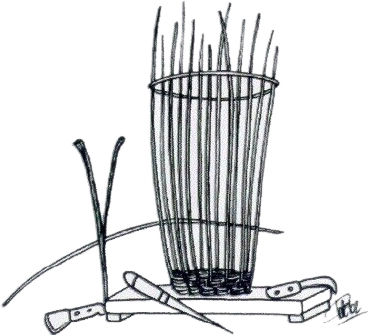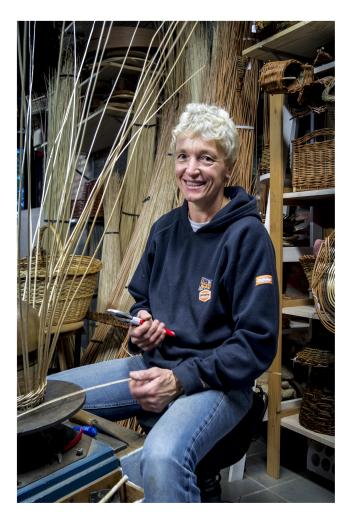About the usage of willow
True to a craftsperson is the manual labor aimed for the production and processing of materials. In a craft like wickerwork with willow, the usage of the right materials is even more so a crucial element.
Willow, or water ditches from a willow, are the long straight shoots that form after a willow is truncated. The willow (Salix) is a genus of deciduous trees and shrubs from the willow family and is found in Belgium along ditches and ponds. As a tree, we know the willow mainly as the pollard willow and the weeping willow (Salix babylonica)
Quality and sustainability are two valuable aspects that hold high importance both for me as a person as well as a craftsperson. Through craftsmanship and the usage of materials with an ecological value, I try my very best to incorporate this into all my work.
I am not a willow breeder myself, and therefore I had to find a good one to collaborate with. "De Vos BVBA" is a company established in Belgium where I get approximately 99% of my material. This way I try to contribute to keeping my ecological footprint as low as possible.
Every once in a while, when on a demonstration at markets abroad, like in Lichtenfels Germany, I buy working tools and different types of willow at Hans Ender en Schardt KG.
The material with which to braid is the annual shoot (not yet shed) of the willow (Salix), also called the "wis" or "wijm." These annual twigs/willow twigs are pruned in the winter when the leaves have fallen. They are then dried and sorted by length.
It is possible to work with:
- Unpeeled willow twigs ( there are different varieties and when drying, each one gets its own specific color)
- Peeled, white willow twigs (peeling is done in the spring when the sap has returned)
- Peeled, brown or tufted willow twigs (are first boiled, giving them a brown color, and then peeled)
- Cleft willow (peeled / debarked willow twigs that are cleaved into shins)
- Shins (these are split willow twigs that have been planed flat and pulled to width for fine shingling, among other things)
Dried willow twigs can be stored for years. To weave, the willow twigs are soaked in water, rain water is fine. The soaking time is about 2 weeks for unbarked willow twigs, a few hours for debarked twigs.
A braider/braider has a whole assortment of twigs in different lengths, thicknesses and types.
In terms of tools, he/she does not need much :
- A board or kind of table, sloping, on which to fix the work;
- Awl to secure the work, also to make space;
- Weights to weigh the work down, gives stability;
- Knock/beat iron to tap the wickerwork;
- Crescent and lancet blades to sharpen erasure;
- Pruning shears to cut erasure over and clean out baskets;
- Cleavers for cleaving erasures into thirds or quarters;
- Planer, whether adjustable or not, to remove the pith and to pull cleaved wipers to thickness;
- Width planer, adjustable or not, to pull shins to equal width;
- Bottom molds for making bottom rings;
- One-piece forming jigs for open falling work; dismountable for narrowing work;
- Round and oval clamping rings;
- Crosses to hold corner posts in place for angular work.
People used to weave baskets for all kinds of purposes, especially functional ones such as potato baskets, picking baskets, duck baskets, etc. Plastic has largely replaced this. Now, in addition to such traditional baskets, one makes mainly design baskets for all kinds of uses, which must be especially beautiful and unique. A niche within this category is customization. So there is still interest in having a rectangular basket woven, but custom made.






